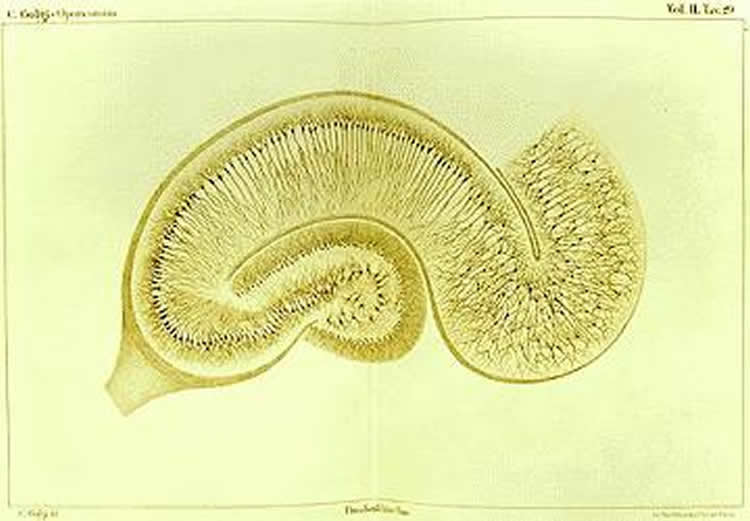Study could improve our insights into brain diseases.
The cannabinoid type 2 receptor – also called “CB2 receptor” – is a special membrane protein. Its function is to receive chemical signals that control cellular activity. “Until now, this receptor was considered part of the immune system without function in nerve cells. However, our study shows that it also plays an important role in the signal processing of the brain,” explains Professor Dietmar Schmitz, Speaker for the DZNE-Site Berlin and Director of the Neuroscience Research Center of the Charité (NWFZ/NeuroCure). Schmitz coordinated the current study, which involved Berlin colleagues and also scientists from the University of Bonn and from the “National Institute on Drug Abuse” of the US.
As the researchers demonstrated in an animal model, the CB2 receptor raises the excitation threshold of nerve cells in the hippocampus. “Operation of the brain critically depends on the fact that nerve impulses sometimes have an exciting impact on downstream cells and in other cases they have a suppressing effect,” says Dr Vanessa Stempel, lead author of the current publication, who is now doing research in Cambridge, UK. “The CB2 receptor works like a set screw by which such communication processes can be adjusted.”
Component of the “endocannabinoid system”
The CB2 receptor is part of the endocannabinoid system (ECS). This family of receptors and signaling substances exists in many organisms including humans. It is a biochemical control system which is involved in the regulation of numerous physiological processes. Its name refers to the fact that chemicals derived from the cannabis plant bind to receptors of the ECS. So far, there are two known types of these receptors: The CB2 receptor has no psychoactive effect. Hence, the mind-altering effects triggered by the consumption of cannabis are ascribed to the “cannabinoid type 1 receptor”.

Potential therapeutic applications
The results of the current study could contribute to a better understanding of disease mechanisms and provide a starting point for novel medications. “Brain activity is disturbed in schizophrenia, depression, Alzheimer’s disease and other neuropsychiatric disorders. Pharmaceuticals that bind to the CB2 receptor could possibly influence the activity of brain cells and thus become part of a therapy,” Professor Schmitz concludes.
Source: Marcus Neitzert – DZNE
Image Source: The image is in the public domain.
Original Research: Abstract for “Cannabinoid Type 2 Receptors Mediate a Cell Type-Specific Plasticity in the Hippocampus” by A. Vanessa Stempe, Alexander Stumpf, Hai-Ying Zhang, Tuğba Özdoğan, Ulrike Pannasch, Anne-Kathrin Theis, David-Marian Otte, Alexandra Wojtalla, Ildikó Rácz, Alexey Ponomarenko, Zheng-Xiong Xi, Andreas Zimmer, and Dietmar Schmitz in Neuron. Published online March 18 2016 doi:10.1016/j.neuron.2016.03.034
Abstract
Cannabinoid Type 2 Receptors Mediate a Cell Type-Specific Plasticity in the Hippocampus
Highlights
•CB2Rs are expressed in hippocampal principal neurons
•CB2Rs mediate a cell type-specific self-inhibitory plasticity in CA3/CA2 PCs
•CB2Rs reduce the spike probability of CA3 PCs and alter gamma oscillations in vivo
•CB2Rs act complementary to presynaptic CB1Rs
Summary
Endocannabinoids (eCBs) exert major control over neuronal activity by activating cannabinoid receptors (CBRs). The functionality of the eCB system is primarily ascribed to the well-documented retrograde activation of presynaptic CB1Rs. We find that action potential-driven eCB release leads to a long-lasting membrane potential hyperpolarization in hippocampal principal cells that is independent of CB1Rs. The hyperpolarization, which is specific to CA3 and CA2 pyramidal cells (PCs), depends on the activation of neuronal CB2Rs, as shown by a combined pharmacogenetic and immunohistochemical approach. Upon activation, they modulate the activity of the sodium-bicarbonate co-transporter, leading to a hyperpolarization of the neuron. CB2R activation occurred in a purely self-regulatory manner, robustly altered the input/output function of CA3 PCs, and modulated gamma oscillations in vivo. To conclude, we describe a cell type-specific plasticity mechanism in the hippocampus that provides evidence for the neuronal expression of CB2Rs and emphasizes their importance in basic neuronal transmission.
“Cannabinoid Type 2 Receptors Mediate a Cell Type-Specific Plasticity in the Hippocampus” by A. Vanessa Stempe, Alexander Stumpf, Hai-Ying Zhang, Tuğba Özdoğan, Ulrike Pannasch, Anne-Kathrin Theis, David-Marian Otte, Alexandra Wojtalla, Ildikó Rácz, Alexey Ponomarenko, Zheng-Xiong Xi, Andreas Zimmer, and Dietmar Schmitz in Neuron. Published online March 18 2016 doi:10.1016/j.neuron.2016.03.034







